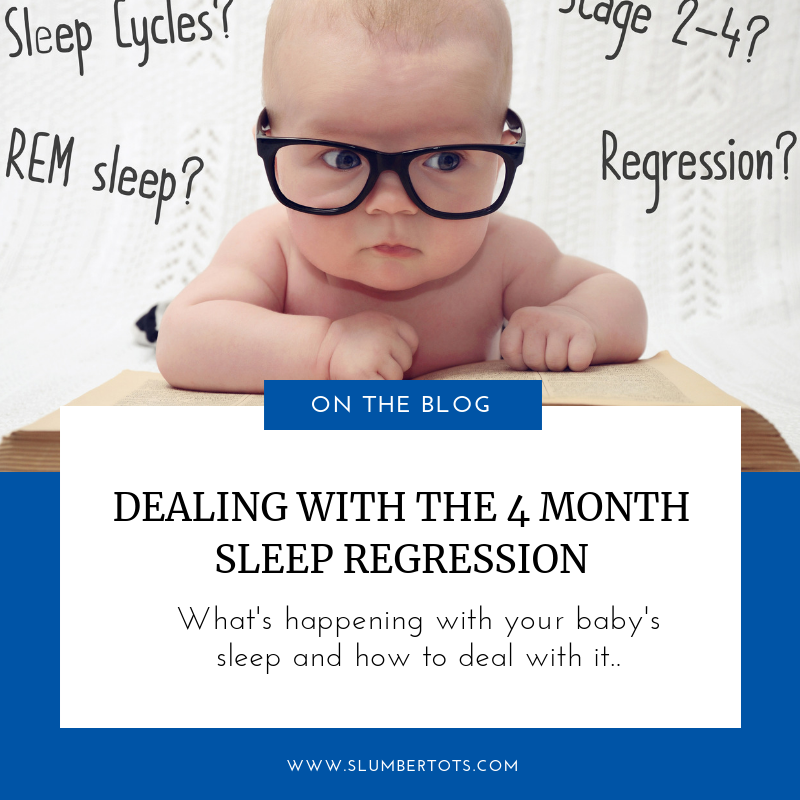I’m going to talk about the four month sleep regression in particular here. As a sleep consultant, I hear the term “regression” used frequently.
 Essentially, if baby doesn’t sleep well for a couple of nights, you might start to wonder if the ‘R’ word starts to creep in.
Essentially, if baby doesn’t sleep well for a couple of nights, you might start to wonder if the ‘R’ word starts to creep in.
Some people subscribe to the idea that there’s an eight month regression, a 9 month regression, a 1 year regression. As well as teething regressions, growth spurt regressions, and so on.
Others see these as simple hiccups caused by extenuating circumstances.
But the four month sleep regression, everybody agrees on, and for good reason. It’s the real deal, and it’s permanent. And “four month sleep regression” is possibly the most uttered phrase by mums in those early months.
What is the four month sleep regression?
To understand what’s happening to your baby during the four month sleep regression, you need to know a few facts about sleep. So here’s the science-y part, told in plain English.
Many of us just think of sleep as an on-or-off situation. You’re either asleep or you’re not.
But sleep actually has a number of different stages. These stages make up the “sleep cycle,” which we go through several times a night.
Stage 1 is that initial stage we’re all familiar with where you can just feel yourself drifting off, but don’t really feel like you’ve fallen asleep.
Stage 2, which is considered the first “true sleep” stage.
This is where people tend to realise, once woken up, that they actually were sleeping.
Stage 3 is deep and regenerative.
Also known as “slow wave” sleep. This is where the body starts repairing the immune system, muscles tissue, energy stores, and growth and development.
Stage 4 is REM (rapid eye movement) sleep.
This is where the brain kicks in and consolidates information and memories from the day before. It’s also where we do most of our dreaming.
Once we’ve gone through all of the stages, we either wake up or come close, then start over again until the alarm sounds.
So what does this have to do with the four month sleep regression we were talking about originally?
Well, newborn babies only have 2 stages of sleep; stage 3, or deep sleep, and REM. They spend about half their sleep in each stage.
What’s happening at the four month mark?
At around the third or fourth month, there is a reorganisation of sleep. Babies embrace the 4-stage method of sleep that they’ll continue to follow for the rest of their lives.
When this change takes place, baby moves from 50% REM sleep to 25% in order to make room for those first two stages.
So although REM sleep is light, it’s not as light as these 2 new stages that they’re getting used to. With more time spent in lighter sleep, there’s more of a chance that baby’s going to wake up.
That’s not to say that we want to prevent or avoid baby waking up.
Waking up is absolutely natural, and we continue to wake up three, four, five times a night into adulthood and even more in old age.
As adults, however, we’re able to identify certain comforting truths that baby might not be privy to.
When we wake in the night, we’re able to recognise that, “Hey, I’m here in my bed, it’s still night time, my alarm isn’t going to go off for another three hours. I can go back to sleep”
And we do. Usually so quickly that, the next morning, we don’t even remember the brief encounter with consciousness.
What does the four month sleep regression mean for my baby?
A four month old baby, of course, lacks these critical thinking skills. To a four month old baby who fell asleep at her mother’s breast, the reasoning could go much more to the tune of, “OK, last thing I remember, there was a familiar, beloved face, I was having dinner, and someone was singing me a soothing song. Now I’m alone in this dark room, there’s no food, and it wasn’t like this when I fell asleep, where is everyone?”
Now that baby’s suddenly realised that Mummy’s not around, and they’re not entirely sure where they’ve gone, the natural response is to do a little freaking out. That stimulates the fight-or-flight response and, next thing you know, baby’s not going back to sleep without a significant amount of reassurance that everything is OK.
The other major contributor to this 4 month sleep regression, is that up until this point, parents have either been putting their baby to sleep with a dummy, or by rocking them, or by feeding them, or some similar technique where baby is helped along on the road to falling asleep.
Now baby’s spending more time in light sleep, they’re more likely to wake up. This suddenly becomes a bigger issue. Hence, the four month sleep regression.
These sleep associations may be helpful in getting your little one to that initial nodding off stage, but the lack of them when they wake up means that baby’s not able to get back to sleep again without some outside help.
When this starts happening every half hour, this can become really challenging for parents.
A regression is defined as “reversion to an earlier mental or behavioural level.” And that’s actually the opposite of what your baby’s experiencing.
This would be much more aptly titled the “Four Month Sleep Progression”
Darkness
So what can you do to help your little one? First off, get all of that light out of baby’s room. You might think that baby’s room is dark enough, or that baby mightn’t like the dark, and it’s comforting to have a little bit of light seeping in.
Nope.
Baby’s room should be dark. I mean coal mine on a moonless night kind of dark. Tape bin bags over the windows if you have to, or cover them with tin foil (in the short term).
Newborns and infants are not afraid of the dark. They are, however, responsive to light. Light tells their brains that it’s time for activity and alertness, and the brain secretes hormones accordingly. So we want to keep that nursery absolutely pitch black during naps and bedtime.
Introduce a bedtime routine
Bedtime routines are also an essential component to getting your baby sleeping well. Try to keep the routine to about 4 or 5 steps, and don’t end it with a feed. Otherwise, you risk baby nodding off at the breast or the bottle. This will create the dreaded “association” we talked about earlier.
So try to keep the feed near the beginning of the routine and plan the songs, stories, and getting into PJs towards the end.
The whole process should be about 30 minutes long, and baby should go into their cot while they’re still awake.
Four month old babies should only be going about 1.5-2 hours between snoozes. Bedtime should be between 6.30 – 7.30pm.
Now, there are going to be regressions, actual regressions, later on in your little one’s youth.
Travelling, illness, teething, all of these things can cause your little one to have a few bad nights in a row.
But when it comes to the four month “progression,” I’m happy to report that this is a one-time thing.
Once you’re through this, your baby will have moved into the sleep cycle that they’ll essentially be following forever.
And by taking this opportunity to teach them the skills they need to string those sleep cycles together, independently, prop-free, without any need for nursing, rocking, or dummies, you’ll have given them a gift that they’ll enjoy for the rest of their young lives.
Of course, some babies will take to this process like a fish to water. And some will be a little more resistant.
For those of you in the latter camp, I’m happy to help in any way I can.
How do I get in touch?
Just join my waiting list to find out more about working together. You’ll complete a few questions that will tell me a bit more about your situation, and I’ll send you some information about how the process works.
My Nap Guide also has lots of tips to help you get the foundations of good sleep in place.
You can also download my FREE guide, Five steps to a better night’s sleep for more tips to help with your little one’s sleep.
